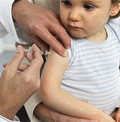 The total number of influenza-associated paediatric deaths reported to the US CDC hit 105 at the end of March. Around 60% of those were in groups considered to be at increased risk of developing serious flu-related complications but the other 40% had no known chronic health problems.
The total number of influenza-associated paediatric deaths reported to the US CDC hit 105 at the end of March. Around 60% of those were in groups considered to be at increased risk of developing serious flu-related complications but the other 40% had no known chronic health problems.
Experts acknowledge the value of collecting this data but it is more challenging to do in the EU than in the US because so many different countries are involved. Greater pan-European coordination efforts are afoot in the area of vaccination but language barriers must be overcome, and more standardisation of how data are collected will be needed.
In the US, annual influenza vaccination is now advised for all children aged 6 months to 18 years of age. It is estimated that 40% of children had received the 2012-2013 influenza vaccine by mid-November 2012. The number has risen slightly since then and may now be close to the final estimated vaccination rate among children for the previous year – 52%.
The CDC said that across all age groups, this season’s flu vaccine was found to be around 60% effective in preventing “medically-attended influenza illness” thus significantly lowering a child’s risk of having to see a doctor for flu symptoms.
Meanwhile the ECDC reports that flu activity is decreasing across Europe. “After more than three months of active transmission, the 2012-2013 influenza season is on the wane,” according to the ECDC’s weekly influenza overview.
However, a spokesperson for the ECDC told Vaccines Today that Europe, unlike the US, does not have a continent-wide mechanism for the reporting of deaths attributable to laboratory-confirmed influenza. Nor are there Europe-wide mechanisms for monitoring vaccination rates of children who succumb to influenza.
The ECDC published technical advice on Seasonal Influenza Vaccination of Children and Pregnant Women in October 2012 which called for stronger disease surveillance across all age groups. The expert report said more information on the impact of flu in younger age groups, as well as on the effectiveness of flu vaccines in children, is required to support parents’ decisions on influenza immunisation.
The lack of EU data makes it difficult to provide evidence-based guidance on immunising healthy children in Europe, the ECDC said. However, a spokesperson noted that the most important group of children to be immunised is those with chronic ill-health. Data from the VENICE project showed that it is policy in almost all EU countries to immunize children with chronic diseases over 6 months of age. How well this is being implemented is not yet clear.




